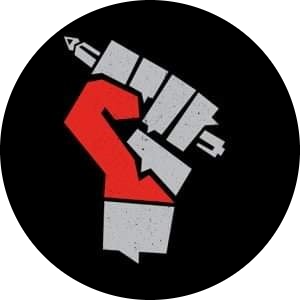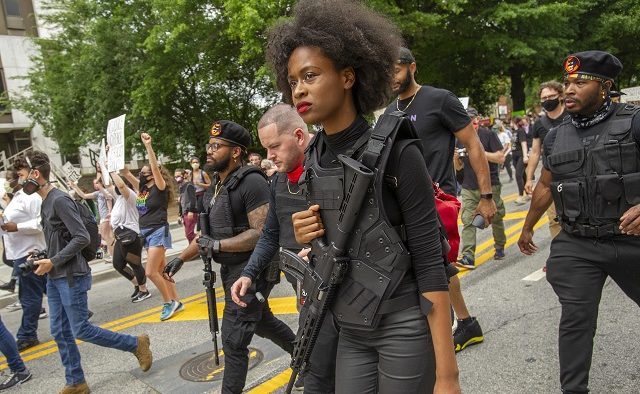Shireen Rizvi explains why the Black Panthers have been flanking protestors in Black Lives Matter protests
Scenes from Black Lives Matter protests across America show that the state has deployed its full force to crush the tide of rebellion on the streets. Amidst scenes of police baton charging, tear gassing and arresting peaceful protestors, a familiar group has resurfaced. Activists calling themselves Black Panthers are forming human chains to protect the marching crowds. It is no surprise that Black Panthers have been spotted at Black Lives Matter protest; the Black Panther Party (BPP) was originally a group for self-defense which became a revolutionary socialist political organisation in October 1966.
The Black Panther Moment
In 1966, President Nixon and his administration began drafting citizens for its deeply unpopular war in Vietnam. At the same time, a revolutionary wave was sweeping across the streets of Oakland, California which transformed the political, social and cultural discourse of white America.
A group of African-Americans going by the name of Black Panthers began resisting police brutality. They were labelled a ‘militant group’ who wore black leather jackets, berets and often openly displayed weapons. Black Panther Party was founded by Huey Newton and Bobby Seal in October 1966. Newton was already a militant activist in 1961 when he met Seale, a fellow student at Oakland’s Merritt College. Both joined the Afro-American Association, a black cultural organization led by Donald Warden, but they became dissatisfied with Warden’s pro-capitalist form of Black Nationalism. Their sentiments were more in accord with those of Malcolm X, especially after his 1964 break with Elijah Muhammad’s Nation of Islam, and of Robert F. Williams, the then Cuban-based guerrilla warfare advocate. After affiliations with the Merritt’s Soul Student Advisory Council and with the Williams-inspired Revolutionary Action Movement, Newton and Seale created the BPP to expand their political activity, which mainly involved “patrolling the pigs” – that is, monitoring police activities in black communities to ensure that civil rights were being respected.
This influx of change began gathering support across the country. BPP chapters expanded from Nashville to New York. Many young people were drawn towards BPP because they had straightforward demands from the state; housing, education and an immediate end to police brutality. This visceral simplicity of BPP opened a new era of mass mobilization. To sustain this support, the Black Panther Party initiated various campaigns like Breakfast for Children. Such initiatives were not only well-received by the community but also triggered unusual anxiety among law enforcement agencies. Among many interesting attributes of BPP was the participation of women in the organization. Women like Elaine Brown and Philliys Jackson challenged the gender divide within the organization by joining the brothers in patrolling and working on breakfast activity.
Meanwhile, the intellectual domain of BPP was led by Eldridge Cleaver which connected the BPP with black intellectuals and white left-wing circles. Eldridge began appearing in talk shows as a representative, which created fandom for Black Panthers almost immediately. While BPP was finding its way through campaigns and seminars, Huey Newton was arrested on murder charges of a police officer on October 26, 1966 by the Oakland Police Department. This sham was plotted by the FBI as a counterintelligence strategy against BPP.
As a result of this, protests broke out in various states across the country. Organizations like the Student Non-Violent Coordination Committee (SNCC) joined the protests and they built a clear narrative from students on this issue.
The protests got heated when Dr King was assassinated. Eldridge Cleaver went into exile and found refuge in Algeria where he opened new chapters of BPP. Meanwhile, David Hilliard took the leadership responsibilities back in the United States. In words of a former party member Flores Forbes, “David was someone at that time who kept the shop in process.”
After Nixon’s landslide win in the 1969 election, the BPP headquarter in New York was raided by the police to investigate the allegation that BPP was planning terrorist attack. An informant who had infiltrated the BPP was responsible for this raid.
As many as 21 core members were arrested ad huge bail charges were placed which none of them could afford. After 13 months of a trial and millions of dollars funding by celebrities, the jury of New York Court found all the members of BPP not guilty.
This victory came with some apprehensions because it left people afraid of joining BPP. Intense scrutiny and surveillance created hesitance among common people. To engage with the public, Bobby Seal appeared in an anti-war demonstration held by Student for Democratic Society Convention in Chicago in 1969. Bobby Seal was indicted for his speech. The judge was requested to postpone the trial till his lawyer came to Chicago but the judge refused to wait.
Eventually, Bobby decided to defend himself. This led to a chaotic trial. Bobby was handcuffed and his mouth was taped but he didn’t stop there. As this medieval torture was on display in a federal courtroom, many students were outside protesting the arrest. During that protest, a new face came to the surface which ultimately grasped the audience by the fury of his words.
Fred Hampton was a young black man who could address 2,000 protesters with exuberance and vigilance. Fred Hampton and field Marshal of BPP Bob Lee led the Black Panther Party towards an inclusive struggle by joining hands with groups like Young Lords, Port Rican Street Groups, and Appalachian White Boys. This movement was no longer moving around just systematic racism but deep-rooted class division.
State Pushback
All of this created tension for the FBI and they tackled it in the most gruesome way. Fred Hampton and Bob Lee were assassinated in their apartment in Chicago. Police labelled it a shootout between party members and police. After that incident, BPP offices were regularly raided and members were arrested.
Keeping in view the rage of the black community, the state decided to release Huey Newton. After Huey Newton got out, BPP began facing an intra-party crisis. Eldridge was still in exile and Bobby Seal decided to run for mayor’s office. A split happened based on differing ideological positions: the democratic section was led by Bobby Seal and the revolutionary section led by Elaine Brown, Kathleen Cleaver and Angela Davis.
Bobby lost the election but kept working within the community while Huey Newton was killed during a drug-related shooting. Eldridge remained in Algeria.
Black Panther Party still exists in fragments but in recent years with the help of the Black Live Matters movement, a surge of mass mobilization created a political sense in modern youth.
Angela Davis defines this enthusiasm in modern youth as revolutionary hope. This hope created an imaginative dimension where we can plan a world of justice and solidarity. What we see today is the solidification of African-American resistance which is the product of resistance movements such as the Black Panthers.
The Students’ Herald News Desk focuses on reporting the latest news regarding student politics and campus updates to you.
The News Desk can be reached at admin@thestudentsherald.com




